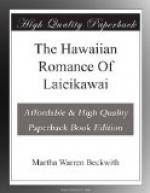The first figure alludes to the well-known fact that the sinking of the Puna coast has left the pandanus trunks standing out in the water, which formerly grew on dry land. The poetical meaning, however, depends first upon the similarity in sound between Ke kua, “to cut,” which begins the parallel, and He Kokua, which is also used to mean cutting, but implies assisting, literally “bracing the back,” and carries over the image to its analogue; and, second, upon the play upon the word ola, life: “The sea floods the isle of life—yes! Life survives in spite of sorrow,” may be the meaning. In the latter part of the song the epithets anuanu, chilly, and hapapa, used of seed planted in shallow soil, may be chosen in allusion to the cold and shallow nature of her love for him.
The nature of Polynesian images must now be apparent. A close observer of nature, the vocabulary of epithet and image with which it has enriched the mind is, especially in proverb or figurative verse, made use of allusively to suggest the quality of emotion or to convey a sarcasm. The quick sense of analogy, coupled with a precise nomenclature, insures its suggestive value. So we find in the language of nature vivid, naturalistic accounts of everyday happenings in fantastic reshapings, realistically conceived and ascribed to the gods who rule natural phenomena; a figurative language of signs to be read as an implied analogy; allusive use of objects, names, places, to convey the associated incident, or the description of a scene to suggest the accompanying emotion; and a sense of delight in the striking or phenomenal in sound, perfume, or appearance, which is explained as the work of a god.
Footnotes to Section III, 4: The Double Meaning
[Footnote 1: See Moerenhout, II, 210; Jarves, p. 34; Alexander in Andrews’ Dict., p. xvi; Ellis, I, 288; Gracia, p. 65; Gill, Myths and Songs, p. 42.]
[Footnote 2: Fison, p. 100.]
5. CONSTRUCTIVE ELEMENTS OF STYLE
Finally, to the influence of song, as to the dramatic requirements of oral delivery, are perhaps due the retention of certain constructive elements of style. No one can study the form of Hawaiian poetry without observing that parallelism is at the basis of its structure. The same swing gets into the prose style. Perhaps the necessity of memorizing also had its effect. A composition was planned for oral delivery and intended to please the ear; tone values were accordingly of great importance. The variation between narrative, recitative, and formal song; the frequent dialogue, sometimes strictly dramatic; the repetitive series in which the same act is attempted by a succession of actors, or the stages of an action are described in exactly the same form, or a repetition is planned in ascending scale; the singsong value of the antithesis;[1] the suspense gained by the ejaculation[2]—all these devices contribute values to the ear which help to catch and please the sense.




